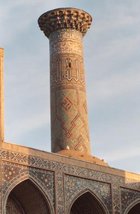Minaret
|
|
Minarets (Arabic Minara pl. Minarat and Urdu: minra pl. minar) are distinctive architectural features of Islamic mosques. Minarets are generally tall, graceful spires, with onion-shaped crowns, usually either free standing or much taller than any surrounding support structure.
| Contents |
History and Evolution
Minarets originally served as beacons of light (deriving from the word noor, which usually translates as light or original light). In more recent times, the main function of the minaret was to provide a vantage point from which the muezzin can call out the adhan, calling the faithful to prayer. However, it should be noted that in most modern Mosques, the adhan is called not in the minaret, but in the musallah, or prayer hall, via a microphone and speaker system. Therefore, the role of the minaret is now largely for traditional and decorative puposes.
Minarets have been described as the "gate from heaven and earth", and as the Arabic language letter alif (which is a straight line).
The world's tallest minaret (at 210 meters) is located at the Hassan II Mosque in Casablanca, Morocco. There are two 230 metre tall minarets under construction in Teheran.
Construction
Minarets basically consist of three parts:
- Base
- Usually the ground underneath the towering minarets is excavated until a hard foundation is reached. Gravel and other supporting materials may be used as a foundation, and it is rare that one is built directly upon ground-level soil.
- Shaft
- Single minarets with in an elongated body are either conical (tapering at the top), cylindrical (a circular shaft) or polygonal (with edges, as opposed to cylindrical). Stairs cirlce the shaft in a counter clockwise fashion, providing a necessary structural support for highly elongated shafts.
- Gallery
- A balcony encircles the upper section where the muezzin will give the call to prayer. It is covered by a roof-like canopy and adorned with ornamentation, such as decorative brick and tile work, cornices, arches and inscriptions. Originally plain in style, a minaret's origin in time can be determined by the level of the gallery's ostentation.
Local Styles
Styles and architecture can vary widely according to region and time period. Here are a few styles and the localites from which they derive:
- Egypt (7th cen) / Syria (until 13th cen)
- Low square towers sitting at the four corners of the mosque.
- Iraq
- Free-standing conical minaret surrounded by a spiral staircase.
- Egypt (15th cen)
- Octagonal. Two balconies, the upper smaller than the lower, over projecting friezes of stalactite vaulting, surmounted by an elongated finial.
- Persia (17th cen)
- Two pairs of slim towers flanking the mosque entrance, terminating in covered balconies and encased in blue tile.
External links
Minaret_Samarra_Iraq.jpg
- Minarets, at the Encylopedia of the Orient (http://i-cias.com/e.o/minaret.htm)
- Minaret Photo Gallery (http://www.islamicfinder.org/gallery/thumbnails.php?album=24)
- Minaret@Everything2.com (http://www.everything2.com/index.pl?node_id=280088)
- Minaret Types (http://www.islamicarchitecture.org/architecture/minaret-types.html) An Architectural review
- 230 metre tall Minarets (http://www.skyscrapercity.com/showthread.php?p=4187232#post4187232) Under construction in Iranda:Minaret
de:Minarett es:Alminar eo:Minareto fr:Minaret he:מינרט nl:Minaret ja:ミナレット pl:Minaret pt:Almádena sv:Minaret

